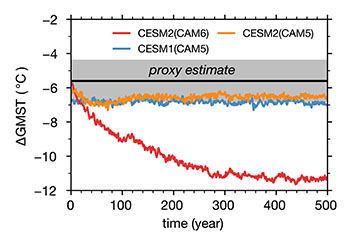Ice Age Testing Reveals Challenges in Climate Model Sensitivity
Increased reflection of incoming sunlight by clouds led one current-generation climate model to predict unrealistically cold temperatures during the last ice age.
Key to the usefulness of climate models as tools for both scientists and policymakers is the models’ ability to connect changes in atmospheric greenhouse gas levels to corresponding shifts in temperature. Equilibrium climate sensitivity (ECS) is one such measure, representing the predicted warming after a doubling of atmospheric carbon dioxide (CO2) levels.
Climate models have traditionally forecast an increase of 1.5°C–4.5°C for a doubling of atmospheric CO2 from the preindustrial climate. However, many of the latest models are finding values in excess of 5°C, which, if correct, would have significant negative implications for our ability to overcome the planet’s ongoing warming. Zhu et al. investigated this trend by using one of the high-ECS models, the Community Earth System Model version 2 (CESM2), to simulate the climate during the culmination of the last ice age, called the Last Glacial Maximum (LGM).
The LGM occurred about 21,000 years ago and is frequently used to evaluate climate models. It represents markedly different conditions from the present, with much lower greenhouse gas levels, large ice sheets covering North America and Europe, and lower sea levels. However, the LGM is sufficiently recent that there is widespread geologic evidence of both climate forcings and resulting surface temperature changes.

The authors configured CESM2 to closely mirror its use in modern climate change research, omitting only those parts (such as vegetation biogeochemistry) for which good data for the LGM are not available. Within 500 model years after initialization, CESM2’s global mean surface temperature plunged to 11°C below the preindustrial era, roughly 5°C cooler than what the geological proxies indicate. In comparison, the model’s predecessor, CESM1, produced values several degrees warmer and within the uncertainty ranges of the proxies.
The authors attribute the discrepancy between CESM1 and CESM2 to how the latter handles clouds. The atmospheric model in CESM2 has been updated so that the computer-simulated clouds behave more like real-world observations, which affects the shortwave cloud feedback, the ability of clouds to reflect incoming sunlight back to space under climate change. When CESM2 was configured to use the older model’s atmospheric package—which lacks these updates—much of the excess temperature decrease disappeared. The authors suggest that CESM2 likely overestimates the shortwave cloud feedback and therefore the ECS.
The results are consistent with those of other studies of current-generation models that show high ECS. The researchers say the findings exemplify the challenge of using present-day observations to constrain future climate change and highlight the value of information from past episodes of climate change. (Geophysical Research Letters, https://doi.org/10.1029/2020GL091220, 2021)
This article appeared on the EOS website at https://eos.org/research-spotlights/ice-age-testing-reveals-challenges-in-climate-model-sensitivity
]]>